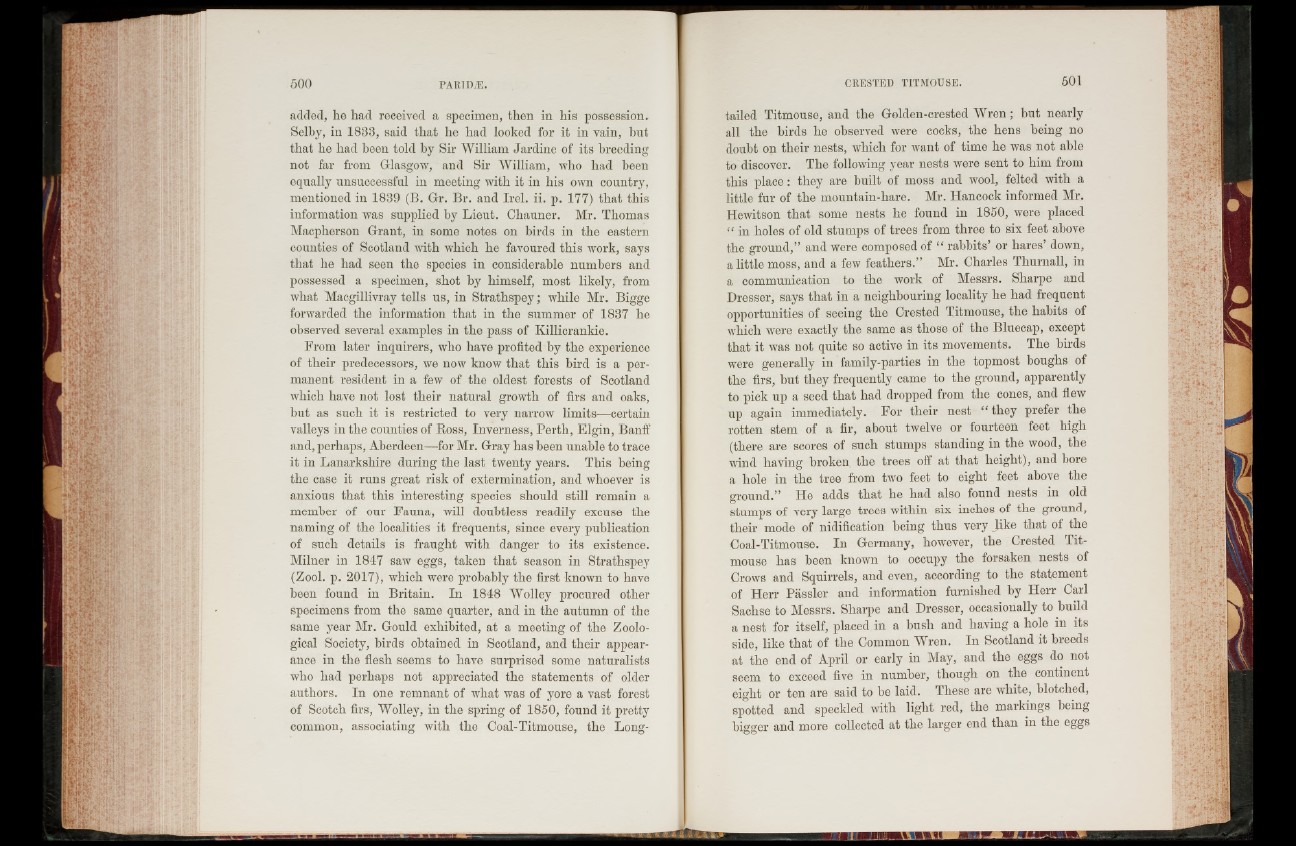
added, he had received a specimen, then in his possession.
Selby, in 1833, said that he had looked for it in vain, hut
that he had been told by Sir William Jardine of its breeding
not far from Glasgow, and Sir William, who had been
equally unsuccessful in meeting with it in his own country,
mentioned in 1839 (B. Gr. Br. and Irel. ii. p. 177) that this
information was supplied by Lieut. Chauner. Mr. Thomas
Macpherson Grant, in some notes on birds in the eastern
counties of Scotland with which he favoured this work, says
that he had seen the species in considerable numbers and
possessed a specimen, shot by himself, most likely, from
what Macgillivray tells us, in Strathspey; while Mr. Bigge
forwarded the information that in the summer of 1837 he
observed several examples in the pass of Killicrankie.
From later inquirers, who have profited by the experience
of their predecessors, we now know that this bird is a permanent
resident in a few of the oldest forests of Scotland
which have not lost their natural growth of firs and oaks,
but as such it is restricted to very narrow limits—certain
valleys in the counties of Boss, Inverness, Perth, Elgin, Banff
and, perhaps, Aberdeen—for Mr. Gray has been unable to trace
it in Lanarkshire during the last twenty years. This being
the case it runs great risk of extermination, and whoever is
anxious that this interesting species should still remain a
member of our Fauna, will doubtless readily excuse the
naming of the localities it frequents, since every publication
of such details is fraught with danger to its existence.
Milner in 1847 saw eggs, taken that season in Strathspey
(Zool. p. 2017), which were probably the first known to have
been found in Britain. In 1848 Wolley procured other
specimens from the same quarter, and in the autumn of the
same year Mr. Gould exhibited, at a meeting of the Zoological
Society, birds obtained in Scotland, and their appearance
in the flesh seems to have surprised some naturalists
who had perhaps not appreciated the statements of older
authors. In one remnant of what was of yore a vast forest
of Scotch firs, Wolley, in the spring of 1850, found it pretty
common, associating with the Coal-Titmouse, the Longtailed
Titmouse, and the Golden-crested W ren ; but nearly
all the birds he observed were cocks, the hens being no
doubt on their nests, which for want of time he was not able
to discover. The following year nests were sent to him from
this place: they are built of moss and wool, felted with a
little fur of the mountain-hare. Mr. Hancock informed Mr.
Hewitson that some nests he found in 1850, were placed
“ in holes of old stumps of trees from three to six feet above
the ground,” and were composed of “ rabbits’ or hares’ down,
a little moss, and a few feathers.” Mr. Charles Thurnall, in
a communication to the work of Messrs. Sharpe and
Dresser, says that in a neighbouring locality he had frequent
opportunities of seeing the Crested Titmouse, the habits of
which were exactly the same as those of the Bluecap, except
that it was not quite so active in its movements. The birds
were generally in family-parties in the topmost boughs of
the firs, but they frequently came to the ground, apparently
to pick up a seed that had dropped from the cones, and flew
up again immediately. For their nest “ they prefer the
rotten stem of a fir, about twelve or fourteen feet high
(there are scores of such stumps standing in the wood, the
wind having broken the trees off at that height), and bore
a hole in the tree from two feet to eight feet above the
ground.” He adds that he had also found nests in old
stumps of very large trees within six inches of the ground,
their mode of nidification being thus very like that of the
Coal-Titmouse. In Germany, however, the Crested Titmouse
has been known to occupy the forsaken nests of
Crows and Squirrels, and even, according to the statement
of Herr Passler and information furnished by Herr Carl
Saclise to Messrs. Sharpe and Dresser, occasionally to build
a nest for itself, placed in a bush and having a hole in its
side, like that of the Common Wren. In Scotland it breeds
at the end of April or early in May, and the eggs do not
seem to exceed five in number, though on the continent
eight or ten are said to be laid. These are white, blotched,
spotted and speckled with light red, the markings being
bigger and more collected at the larger end than in the eggs